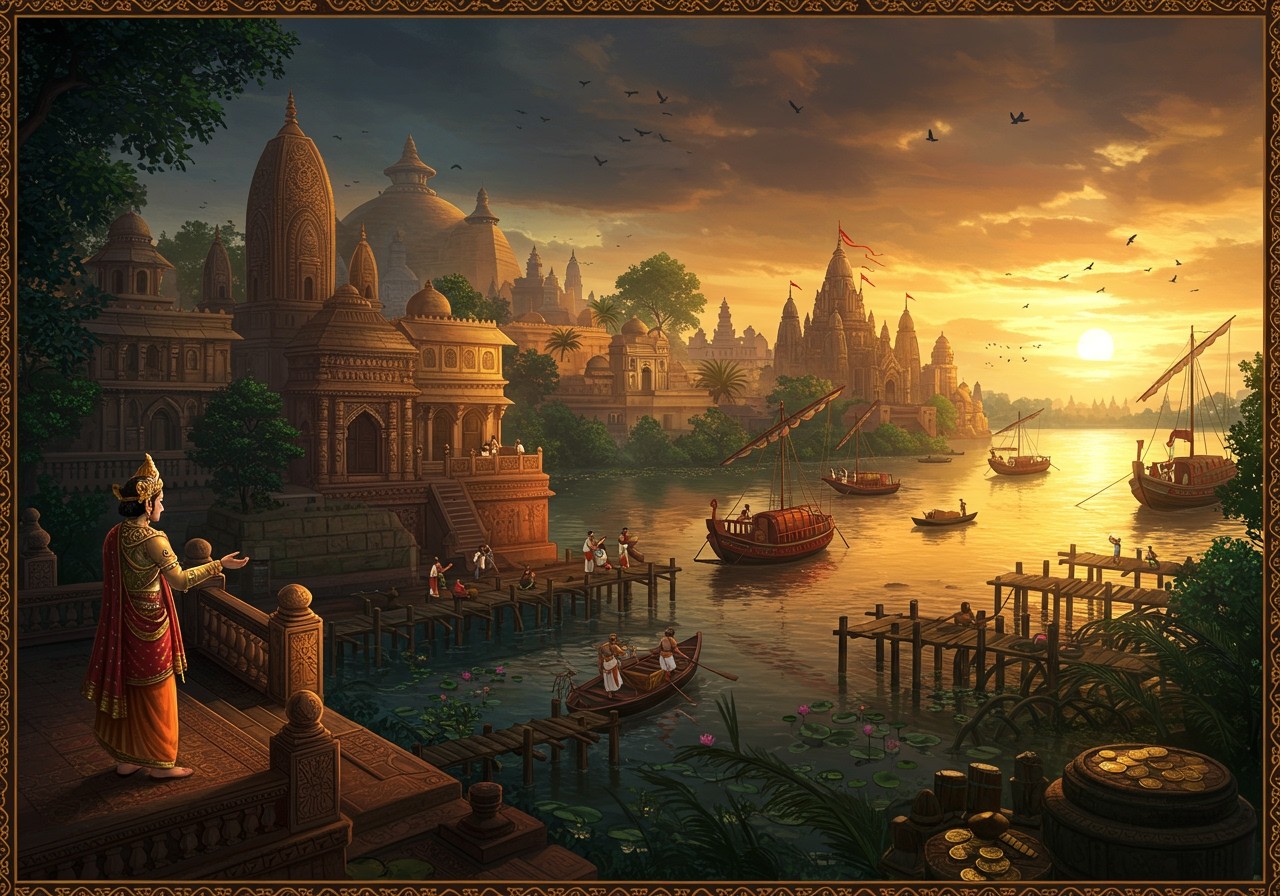
Often overshadowed by more prominent empires, the kingdom of Samatata holds a unique place in India’s rich tapestry of history. Nestled in the southeastern part of Bengal (present-day Bangladesh), this ancient kingdom played a crucial role in shaping the region’s cultural and economic landscape. Let’s embark on a journey to uncover the story of Samatata, from its origins and cultural significance to its eventual decline.
The Rise of Samatata: Geography and Formation
The geographical location of Samatata significantly influenced its development. Surrounded by natural barriers like rivers and hills, the region occupied a strategic position. This unique geography not only provided fertile land for agriculture but also fostered trade routes connecting India with Southeast Asia, leading to economic prosperity and cultural exchange with neighboring territories. Samatata emerged as a Janapada, a territorial division, during a time when several such states flourished across ancient India. This period, marked by the rise of kingdoms like Magadha (6th-8th century BCE) and the later Maurya Empire (around 322 BCE), saw significant political and cultural transformations across the subcontinent.
Samatata’s Capital: A Hub of Power and Culture
The capital city of Samatata served as a powerful symbol of the kingdom’s authority and cultural richness. Archaeological findings point towards a well-planned urban center with impressive architecture. Beyond its political function, the capital was a melting pot of diverse religious practices, as evidenced by the presence of numerous temples. Bustling marketplaces and vibrant streets further contributed to the city’s dynamic atmosphere, making it a true reflection of Samatata’s flourishing society.
-
Temples and Religious Practices: The capital city housed various temples, reflecting the spiritual diversity of Samatata. The coexistence of different religious practices points to a society that valued tolerance and cultural exchange, much like the Gupta Empire (320-550 CE), known for its religious harmony.
-
Markets and Trade: The bustling markets within the capital played a vital role in Samatata’s economy. They served as centers of commerce, connecting local artisans and farmers with traders from far-off lands. The vibrant exchange of goods and ideas further enriched the kingdom’s cultural landscape.
Looking to enhance the spiritual atmosphere in your home? Poojn.in offers a divine collection of Panchmukhi Hanuman idols and Lord Kubera murtis, crafted with utmost reverence to bring blessings and prosperity into your lives.
Samatata’s Coinage: A Symbol of Prosperity
The coinage system of Samatata provides valuable insights into its economic strength and trade relations. Intricately designed coins, often bearing inscriptions, served not only as currency but also as symbols of the kingdom’s authority and prosperity. Similar to the Chola Dynasty (3rd century BCE – 13th century CE), known for its maritime trade, Samatata’s coins circulated widely, indicating the kingdom’s extensive trade network and its influence in the region.
Cultural and Religious Influences
Samatata’s culture was a vibrant blend of various influences, shaped by its interactions with neighboring regions. The kingdom’s religious landscape was particularly diverse, with a multitude of practices coexisting harmoniously. The flourishing of art and literature further enriched Samatata’s cultural heritage, leaving a lasting impact on the region. Many festivals celebrated in Samatata continue to resonate in present-day traditions, showcasing the enduring legacy of this ancient kingdom.
The Decline and Enduring Legacy
Like many ancient kingdoms, Samatata eventually faced a period of decline. Political instability, coupled with external invasions and shifting trade dynamics, contributed to its downfall. However, the kingdom’s legacy has endured, woven into the historical and cultural fabric of the region. Remnants of Samatata’s influence can be observed in local customs, traditions, and historical narratives, emphasizing the importance of preserving this heritage for future generations.
Poojn.in: Preserving Cultural Heritage
At Poojn.in, we are dedicated to preserving India’s rich cultural heritage. As India’s leading online store for puja samagri and other spiritual items, we understand the deep connection between tradition and ritual. We offer a wide selection of authentic puja items, sourced with care and respect for tradition. Just as ancient kingdoms like Vijayanagara (known for preserving Hindu culture) and the Rajput kingdoms (7th century onwards) played a role in safeguarding cultural traditions, Poojn.in strives to make these traditions accessible to everyone.
-
Traditional Puja Items: Discover a wide array of traditional puja items, including Arjun Chal and Ashoka Chal, essential for various rituals.
-
Expert Guidance: Our team of experts is available to provide personalized guidance on selecting the appropriate items for your specific needs. We understand the nuances of different rituals and can assist you in making informed choices.
Visit www.poojn.in today to explore our complete collection and experience the convenience of online shopping for all your spiritual needs.
Understanding Samatata’s Significance
What made Samatata historically significant? Samatata’s strategic location made it a vital hub for trade and cultural exchange between India and Southeast Asia. It was also a significant political entity during a period of evolving kingdoms in ancient India.
Where was Samatata’s capital? The capital of Samatata was situated in the southeastern Bengal region, which is present-day Bangladesh. This strategically important location played a key role in the kingdom’s development.
How did Samatata influence trade? Situated near the Bay of Bengal, Samatata facilitated maritime trade routes and played a central role in the exchange of goods like spices, textiles, and precious metals. Its trade connections extended to Southeast Asia, making it an important player in the region’s economic landscape.
What was the Samatata janapada? The Samatata janapada was a territorial and political division in ancient India, similar to other janapadas that existed during that time. It represents an early form of political organization in the region.
Did Samatata have its own coinage? Yes, Samatata had its own distinct coinage, a testament to its economic prosperity and established trade networks. The coins often featured unique inscriptions and symbols.
What led to Samatata’s decline? Several factors contributed to Samatata’s decline. These factors include external invasions, the changing dynamics of trade routes, and internal political conflicts.
Is there archaeological evidence of Samatata? Archaeological findings, such as ruins and inscriptions, provide tangible evidence of Samatata’s existence, offering insights into its history, culture, and significance in the region.
How is Samatata’s legacy remembered? Samatata’s legacy lives on through its contributions to trade, culture, and the political landscape of ancient India. Historians and archaeologists continue to study its remnants, enriching our understanding of the past. You can learn more about the architectural wonders of other ancient kingdoms like the Sas Bahu Temples and Chandela Dynasty architecture through our informative blogs at Sas Bahu Temples and Chandela Dynasty Architecture.
Explore the architectural marvels of Dravidian temples in South India with our insightful guides. Discover the key features of these ancient structures in our blog post Dravidian Temples: A Guide to Their Key Architectural Features. Delve deeper into the rich history of South Indian temples through our exploration of Dravidian architecture in Exploring Dravidian Architecture: South India’s Ancient Temples.


